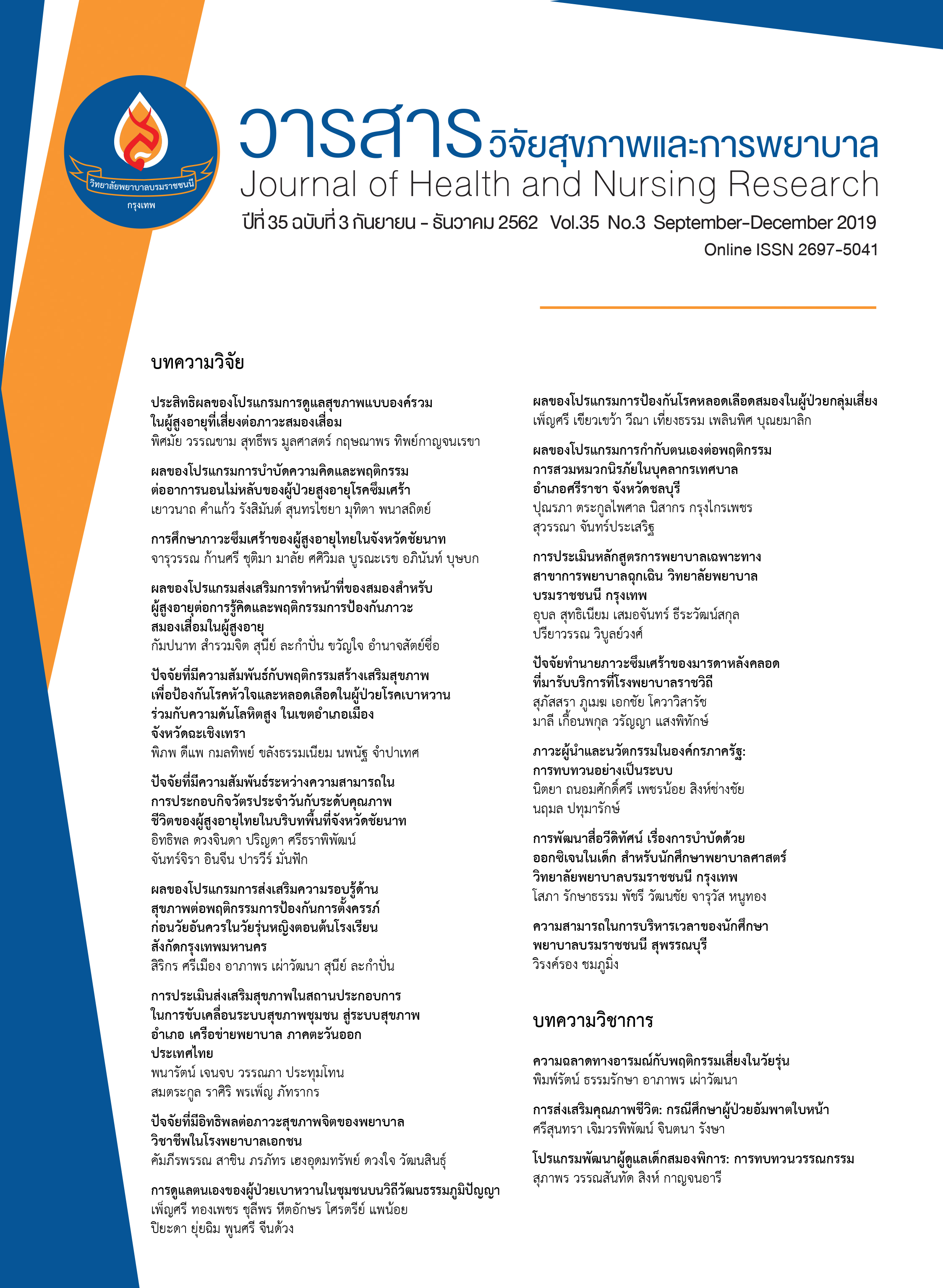ปัจจัยทำนายภาวะซึมเศร้าของมารดาหลังคลอดที่มารับบริการ ที่โรงพยาบาลราชวิถี
คำสำคัญ:
ภาวะซึมเศร้า, มารดาหลังคลอด, ภาวะเครียดบทคัดย่อ
การศึกษานี้มีวัตถุประสงค์เพื่อหาปัจจัยทำนายที่ส่งผลให้มารดาหลังคลอดเกิดภาวะซึมเศร้า การศึกษาอุบัติการณ์ สาเหตุหรือปัจจัยภาวะซึมเศร้าหลังคลอด ซึ่งอาจเกิดขึ้นจากประสบการณ์คลอด และปัจจัยที่เป็นข้อบ่งชี้ว่าจะเกิดภาวะซึมเศร้าของมารดาหลังคลอด การศึกษาครั้งนี้เป็นการเก็บข้อมูลไปข้างหน้าในระยะยาวในกลุ่มมารดาหลังคลอดที่มารับบริการ ที่แผนกหลังคลอดสามัญจำนวน 2 ตึกของโรงพยาบาลราชวิถี จำนวน 500 คน ระหว่างดือนมิถุนายน 2560 ถึง เดือนธันวาคม 2561 โดยใช้แบบสอบถามข้อมูลทั่วไปของผู้รับบริการ แบบคัดกรองภาวะซึมเศร้า (2Q) และแบบประเมินโรคซึมเศร้าด้วย 9 คำถาม (9Q) ของกรมสุขภาพจิตของประเทศไทย โดยเก็บข้อมูลในระยะ 48-72 ชั่วโมงแรกหลังคลอด เพื่อซักถามอาการบาดเจ็บ การรักษาพยาบาลที่ได้รับ และประเมินด้วยแบบคัดกรองโรคซึมเศร้า (2Q, 9Q) ก่อนมารดากลับบ้าน วิเคราะห์ข้อมูลทั่วไปโดยใช้สถิติจำนวน ร้อยละ และค่าเฉลี่ย ส่วนปัจจัยทำนายความผิดปกติหลังเกิดความเครียดที่สะเทือนใจของมารดาหลังคลอด ใช้สถิติถดถอยด้วยวิธีเสตปไวท์
ผลการวิจัยพบว่า มี 4 ปัจจัยที่ส่งผลให้มารดาหลังคลอดเกิดภาวะซึมเศร้า ตัวแปรที่สามารถทำนายได้โดยเรียงจากมากที่สุดไปหาน้อยสุด 1) การมีที่คนคอยให้การช่วยเหลือเมื่อเกิดความเครียด 2) คือระดับความปวดในระยะหลังคลอด 3)การมีประวัติเคยถูกทำร้ายด้านจิตใจในช่วง 4-6 สัปดาห์ก่อนคลอด 4) ช่วงอายุร 5) การมีแผลฝีเย็บ และ 6)อาชีพของหญิงตั้งครรภ์ ตามลำดับ ซึ่งสามารถร่วมกันทำนายภาวะซึมเศร้าของมารดาหลังคลอดได้ ร้อยละ 20.3 อย่างมีนัยสำคัญทางสถิติ (p < .001)
ข้อเสนอแนะ ควรมีการให้คำปรึกษาเพื่อป้องกันภาวะซึมเศร้าของมารดาหลังคลอด แก่หญิงตั้งครรภ์และครอบครัวเพื่อให้เข้าใจการเปลี่ยนแปลงร่างกายของหญิงตั้งครรภ์ และการให้สมาชิกในครอบครัว โดยเฉพาะสามีควรให้การดูแลมารดาหลังคลอดอย่างใกล้ชิด
Downloads
เอกสารอ้างอิง
2. Hutti MH. Social and professional support needs of families after perinatal loss. JOGNN 2004;(34)5:630-8.
3. Ayers L. Synthesizing timbre tremolos and flutter tonguing on wind instruments, proceedings of the 2004 international computer music conference. Miami, FL 2004; 390-3.
4. World Health Organization. Maternal mental health. [Internet]. 2015. [cited 2016 Sep 15]. Available from: http://www.who.int/mental_health/maternal-child/maternal_mental _health/en/
5. Nivin T. Understanding postpartum depression-the basics. [Internet]. 2015. [cited 2015 March 31]. Available from: http://www.webmd.com/depression/postpartumdepression/understandingpostpartum-depression-basics
6. Hoang OT, Deoisres W, Suppaseemanont W. Factors predicting postpartum depression among women in Hai Phong City, Vietnam. Journal of Boromarajonani Collage of Nursing, Bangkok 2016;32(1):92-104. (in Thai).
7. Sriarporn P, Suntornlimsiri N, Juntratit K, Deeluea J, Nunchai J, Khiaokham P. Factors retated to postpartum depression among first time mothers and father. Nursing Journal 2015;42(3):37-50. (in Thai).
8. Pukdeesamai A, Sriarporn P, Xuto P. Factors predicting postpartum depression among first-time mother. Nursing Journal 2017;44(3):19-29. (in Thai).
9. National Institute of Mental Health. Postpartum depression facts. [Internet] 2017. [cited 2018 May 15]. Available from: from https://www.nimh.nih.gov/health/publications/postpartumdepression-facts/postpartum-depression-brochure_146657.pdf
10. Paulson, James F. "Focusing on depression in expectant and new fathers: prenatal and postpartum depression not limited to mothers". Psychiatry Times. 2010; 27(2):48 Available from:https://go.gale.com/ps/anonymous?id=GALE%7CA218449822&sid=googleScholar&v=2.1&it=r&linkaccess=abs&issn=08932905&p=AONE&sw=w
11. Pearlstein T, Howard M, Salisbury A, Zlotnick C. Postpartum depression. American Journal of Obstetrics and Gynecology 2009;200(4):357–64.
12. Avital O, Schub T. Postpartum Depression. Pravikoff D. (ed.) Quick lesion. Cinahl Information systems, a division of EBSCO Information Services; 2018.
13. Smith N. Chinese Patients: Providing Culturally Competent Care to Prevent and Treat Postpartum Depression. Pravikoff, D.(ed.). Nursing Practice & Skill. Cinahl Information systems, a division of EBSCO Information Services; 2017
14. Cirik DA, Yerebasmaz N, Kotan VO, Salihoglu KN, Akpinar F, Yalvac S, Kandemir O. The impact of prenatal psychologic and obstetric parameters on postpartum depression in late-term pregnancies: a preliminary study. Taiwanese Journal of Obstetrics & Gynecology 2016;55(3): 374-8
15. Harkins B. Thailand Migration Report 2019. Thailand: Ainergy Studio Company Limited; 2019.
16. The newborn baby was throw away by mother form condominium. (2017). [cited 2019 May 10]. Available from: https://www.youtube.com/watch?v=_15IYj6s1VE
17. The newborn baby was throw away by mother form apartment. (2018). [cited 2019 May 10]. Available from: https://www.youtube.com/watch?v=eNkKnwXQO4U
18. Beck CT. Predictors of postpartum depression. Nursing Research 2001;50(5):275-85.
19. House JS. Work stress and social support, MA: Addison-Wesley; 1981.
20. Department of Mental Health, Thailand. (2016). Questionnaire of depression. [cited 2017 April 10] Available from: https://www.dmh.go.th/test/download/view.asp?id=22
21. Henshaw EJ, Fried R, Siskind E, Newhouse L, Cooper M. Breastfeeding self-efficacy, mood, and breastfeeding outcomes among primiparous women. Journal of Human Lactation 2015;31(3):511-8.
22. Schiebel DA, Levy G. Evidence-base care sheet: breastfeeding and postpartum depression. Pravikoff D.(ed.). Nursing Practice & Skill. Cinahl Information Systems, A Division of EBSCO Information Services; 2018
23. Ystrom E. Breastfeeding cessation and symptoms of anxiety and depression: a longitudinal cohort study. BMC Pregnancy and Childbirth 2012;12:36. [cited 2017 April 10] Available from: https:// bmcpregnancychildbirth.biomedcentral.com/track/pdf/10.1186/1471-2393-12-36.
24. Sharma V, Corpse CS. Case study revisiting the association between breastfeeding and postpartum depression. Journal of Human Lactation 2008;24(1):77-9.
25. Zauderer C, Galea E. Breastfeeding and depression: empowering the new mother. British Journal of Midwifery 2010;18(2):88-91.
26. Tang L, Zhu R, Zhang X. Postpartum depression and social support in China: a cultural perspective. Journal of Health Communication: International Perspectives 2016;21(9):1055-61.
27. Wouk K, Stuebe AM, Meltzer-Brody S. Postpartum mental health and breastfeeding practices: an analysis using the 2010-2011 pregnancy risk assessment monitoring system. Maternal and Child Health 2017;21(3):636-47.
28. Tang L, Zhu R, Zhang X. Postpartum depression and social support in China: a cultural perspective. Journal of Health Communication: International Perspectives 2016;21(9):1055-61.
29. Calple C. Woten M. Postpartum Depression: Psychosocial Support. Evidence-Based Care Sheet. Pravikoff, D.(ed.). Nursing Practice & Skill. Cinahl Information Systems, A Division of EBSCO Information Services; 2018.
30. Eisenach JC, Pan PH, Smiley R, Lavand P, Landua R, Houle TT. Severity of acute pain after childbirth, but not type of delivery, predicts persistent pain and postpartum depression. ELSEVIER 2008;140(1):87-94.
31. Lowdermilk DL. Postpartum Complications. In: Perry SE, Hockenberry MJ, Lowdermilk DL, Wilson D. Maternal and child nursing care. (8th ed). Maryland Heighte, M: Mosby Elsever 2010; p. 741-50.
32. Chongpanish D, Kaewprom C, Pisaipan P, Pratoom L. Survey of understanding and attitudes amongst relatives regarding postpartum depression. The Journal of Boromarajonani College of Nursing, Nakhonratchasima 2014;20(1):44-54. (in Thai).
33. Sunsaksawat N, Hengudomsub P, Vatanasin D, Pratoomsri W. Factors influencing depression among mothers of pregnancy teenage daughters. Journal of Boromarajonani College of Nursing, Bangkok 2017;33(3):47-58. (in Thai).
34. Pummanee N. Depression after childbirth among teenage mothers at Sirindhorn Hospital Medicine Service Department. [Master’ thesis]. Bangkok: Chulalongkorn University; 2013 [cited 2017 April 10] from: http://cuir.car.chula.ac.th/bitstream/123456789/43524/1/5574355930. pdf
35. Dunn AB, Paul S, Ware LZ, Corwin EJ. Perineal injury during childbirth increases risk of postpartum depressive symptoms and inflammatory markers. Journal of Midwifery & Amp; Women Healthn 2015;60(4) [cited 2018 April 10] from: https://onlinelibrary.wiley.com/doi/abs/10.1111/jmwh.1229
36. Dunn A, Paul S, Corwin E. Perineal injury during childbirth increases inflammatory response and risk of postpartum depression. ELSIER 2014; p. 40:2
37. Lewis BA, Billing L, Schuver K, Gjerdingen D, Avery M, Marcus B. The relationship between status and depression symptomatology among women at risk for postpartum depression. Women Health (Lond) 2017;13(3):3-9 [cited 2018 April 10] from: https://www.ncbi.nlm.nih.gov/pubmed/28480799
ดาวน์โหลด
เผยแพร่แล้ว
รูปแบบการอ้างอิง
ฉบับ
ประเภทบทความ
สัญญาอนุญาต
บทความที่ได้รับการตีพิมพ์ เป็นลิขสิทธิ์ของวารสารวิจัยสุขภาพและการพยาบาล (วิทยาลัยพยาบาลบรมราชชนนี กรุงเทพ) ไม่สามารถนำไปตีพิมพ์ซ้ำในวารสารฉบับอื่น


















